#usability evaluation method
Explore tagged Tumblr posts
Note
merry half past noon it's question time :D I was thinking about leadership styles, Hongjoong and Bang Chan have both said before that they used to be quick to anger and generally it seems as if their style of leadership was (maybe is?) to set the course of the group and scold whoever gets out of line. Since you mentioned you're a team lead yourself, how does this compare with your experience of leadership in regular companies? Is it top down/authorative, more collaborative, or something else?
I'm going to be vulnerable here and acknowledge that I actually learned a lot of things that are directly usable in my career from these two kpop idols (Bang Chan and Hongjoong) and their crafting of the ideal Korean (male) professional self. Despite their being singer-dancer-musicians in entertainment and me having a job where everyone is seated 120% of the time, I have important points I can identify with in both of them. BangChan is both Westernized (he's got a strong identity as an Aussie) and yet adheres to a lot of very Korean-specific values, like me. Hongjoong is a monomaniacal perfectionist with a confrontational streak, like me. They also work in a small unit (though bigger than mine) composed of people who are all very strong personalities, who are proud, tough, and great at what they do, like me.
From actual experience what I've begun to think is that a quick-to-anger leader is a green, inexperienced one. Having to scold people is also sign of inexperience by the leader more than it constitutes a 'style.' I say this because when I first was appointed 'leader' I was exactly like this- quick to anger, and finding myself constantly saying, No, and That's Not It and Stop That. When you've been an exceptional solo performer, you believe - because it's true! - that you were given your leadership spot because of your skills and the way you deploy those skills. As a result, there is an initial urge to demand adherence to your method from the people over whom you have authority.
People, I have learned, hate this, especially coming from a 'leader' who is exactly the same age or a very near contemporary. My direct reports to date have all been 7 or more years (up to 20 years) older than me, and I'm always actually interested in absorbing other people's methodology, so I didn't resist them, but my gender, age, and weirdness were the key to allowing this to happen. The fact that for both the men and women in my group, I'm the very first or the very second woman leader they've ever had also made things more complicated.
What I learned from Bangchan is that you need to accept everyone else already knows you hold a lot of power, and have a lot of skills, and let the reins drop. You think they're reins because you're holding them, but to everyone else it's a noose. What people want from you is for you to give them space to extend and stretch themselves. When he told Hongjoong at their Kingdom meet'n' greet that he has a member (Changbin) who really 'doesn't obey,' what he does is leave him be? That's actually a great management skill and very difficult to enact. Stopping talking is so hard to do, when you actually have the organizational/ political power to say however much you want. Hongjoong expresses admiration for this, and says he still has a hard time doing that with his problem person (Wooyoung). Banchan's way of exercising power is that he takes all the blame, and the responsibility, but the credit he explicitly delegates to everyone but him. This is actually very wise - it makes it safe for people to tell you what's really going on (bc you'll take responsibility) and the act of acknowledging credit places you in the position of evaluative expert, rather than competitor who has an edge in authority, which makes for much better team cohesion.
Hongjoong, being a little bit more emotionally reserved and defensive than Bang Chan, instituted a communications method he seems to have liked, which is to hold formal weekly meetings. He forced people to talk to him, until they all figured out how to communicate in a more natural way. Once I felt like I hit a depressing kind of wall in intra-group communications, I did something similar (before I knew about Ateez but still) - where I scheduled a meeting, formally, in a conference room, with each member of my group to ask, What Can I Do Better? What Do You Want More Of? and such. I didn't have very high hopes that anyone would actually answer these questions, but to my surprise, THEY DID. They had lots to say! And a lot of it was very valid and and I wanted to help them do it! And doing that just a couple times - the opening talk and then, a little later, another one to ask if they felt like we (them and I, and the group) were on the right track - made the following year GO SO MUCH BETTER.
As for the rest of the company I work in? There was an abrupt shift as each new generation came to the fore, I think, after their cautious newbie years were done, you know? Korean Boomers lived in a very up down, hierarchical, stfu world. Gen Xers started to point out the problems with that approach - important information gets lost on its way up any ladder. Millennials were the biggest jump, demanding feedback and opportunities to provide feedback. Nowadays, there's a general principle or ideal that everyone should have a voice, that all viewpoints should at least be aired, if not considered. However, in the final analysis, the ultimate decisions are still up down, and the thought process completely opaque, sad to say.
#real life lessons from kpop idols#ateez meta#hongjoong meta#stray kids meta#bangchan meta#kpop ask#ateez ask
13 notes
·
View notes
Text
Automated Testing vs. Manual Testing: Which One is Right for Your Project?
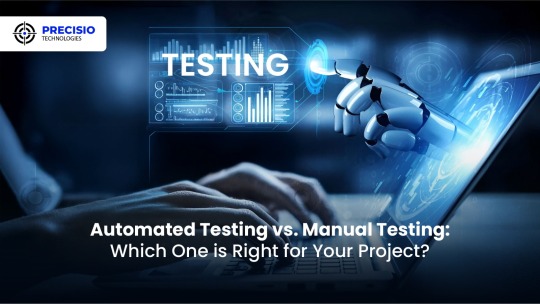
Achieving high-quality, reliable software stands as a fundamental requirement in software development. Successful testing functions as an essential tool to discover faults and build performance capabilities that create better user experience outcomes. Two main testing methods dominate the field: automated testing and manual testing. The process of quality software assurance uses different testing approaches that demonstrate their own advantages as well as weaknesses according to specific project requirements and scenarios. We will explore the specifics to determine which testing process works best for your system development efforts.
1. What Is Manual Testing?

Manual testing involves a human tester manually executing test cases without using automation tools. Key Characteristics:
The methodology focuses its efforts on user interface together with usability and experience testing.
Human-centered applications where selection requires discretion include ad hoc testing and enumerative testing as well as examinations that need human evaluation.
Human performers are required during this approach; thus, it demands substantial time.
2. What Is Automated Testing?
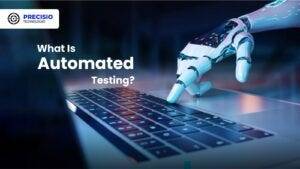
Software performing automated testing executes test cases through workflows and helpers. Key Characteristics:
Efficient for repetitive and regression testing.
Users must spend money on tools along with developing custom scripts for testing.
Reduces human error.
3. Advantages of Manual Testing

Human Intuition: Software testing professionals can detect kernels through their human cognitive ability that automated tools cannot match. The observation and evaluation of visual elements runs more efficiently through human operatives instead of advanced tools.
Flexibility: This method suits exploratory testing specifically because there are no pre-determined scripts available.
Low Initial Investment: Running this approach does not need tool purchases or applications to develop automation frameworks.
Adaptable for UI/UX Testing: Running this approach does not need tool purchases or applications to develop automation frameworks.
4. Advantages of Automated Testing
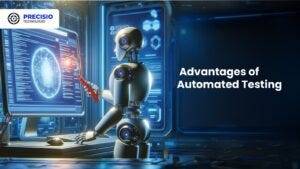
Speed: Executes repetitive tests much faster than humans.
Scalability: The system proves most effective for extensive projects that need constant system updates.
Accuracy: When performing recurring actions, automated systems minimize the chances of human mistakes.
Cost-Efficient in the Long Run: Once established and implemented, the system demands costly investments but ensures continuous development expenses decrease over time.
Better for CI/CD Pipelines: Such testing technology connects various development pipelines that support agile and DevOps methodologies.
5. Disadvantages of Manual Testing
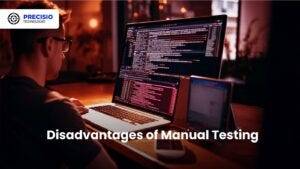
Time-Consuming: The manual performance of repeated tests leads to delayed completion of projects.
Error-Prone: Large applications contain tiny bugs that human testers commonly fail to detect.
Not Ideal for Scalability: The process of increasing manual testing needs additional testers to avoid cost escalations.
6. Disadvantages of Automated Testing

Initial Costs: Organizations must provide high financial resources to procure testing tools together with developing programming constructs.
Limited to Pre-Defined Scenarios: These testing approaches work poorly for handling exploratory or ad hoc testing.
Requires Maintenance: Test scripts need frequent updates when application changes occur.
Not Suitable for UI/UX Testing: Struggles with subjective user experience evaluations.
7. When to Use Manual Testing

Small Projects: The testing method proves beneficial at a low cost for small applications and provides quick assessments.
Exploratory Testing: Testing this approach benefits projects whose scripts have not been defined yet or need evaluation for newly added features.
Visual and Usability Testing: Performing assessments on interface components together with design features.
8. When to Use Automated Testing
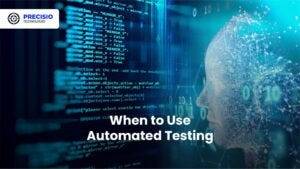
Large Projects: Handles scalability for projects with frequent updates.
Regression Testing: Program testing becomes more efficient through automation since automated assessments perform multiple tests following each update process.
Performance Testing: The system performs efficient capabilities to conduct load testing and stress testing.
Continuous Development Environments: Agile progression and DevOps implementations need automation as a core requirement.
READ MORE- https://www.precisio.tech/automated-testing-vs-manual-testing-which-one-is-right-for-your-project/
2 notes
·
View notes
Text
User Experience Research vs. Usability Testing: Understanding the Difference

“User experience”
“Usability”
“User experience research”
“Usability testing”
New designers often use the terms interchangeably.
That’s because all of these terms are related. But, they are not identical:
User experience (UX) research and usability testing are both critical research methodologies in digital design
But, they are conducted at different stages of the design process and they serve different purposes
Similarly, it is vital for a digital product to offer both good UX and usability
But again, UX is not usability
In this article, we’ll list the differences between these terms.
We’ll explain:
What is user experience (UX)?
What is usability?
What is UX research?
What is usability testing?
Differences between UX research vs. usability testing
What is User Experience?
User experience (UX) refers to all aspects of a user’s interaction with a digital product and the brand behind it:
How users feel about using the product
How easily users can access and use the product
How users feel when using the product – do their experiences feel meaningful or personally relevant
The range of features in the product and how well they meet user needs
The visual appeal and design quality of the product
The goal of UX design is to make a product exciting to interact with before, during, and after using the product
Since it is not easy to create comprehensive experiences that effectively meet all user needs, UX research and research-based iterations are huge parts of the UX design process.
What is Usability?
Usability is an aspect of the user’s experience (UX) that focuses on how easily users can interact with the product and accomplish specific goals.
A product’s usability is defined by its:
Learnability: How quickly users can perform basic tasks the first time they encounter the product and its interface and UX design
Efficiency: How quickly can users perform essential tasks within the product?
Memorability: How easily can users return to the product after not using it for a while?
Error-Handling: The frequency of errors users face within the product and their ability to recover from them
Usability is just one of the many components of UX - albeit a critical component.
UX covers a broader range of components that contribute to how users perceive ALL of their interactions with the product.
It even covers things like how meaningful, valuable, or personally relevant the product feels to users.
What is UX Research?
User Experience or ‘UX’ research covers various qualitative and quantitative research methods
All of these research methods aim to capture a user base’s needs and expectations regarding a product or service
UX research can be conducted at all stages of product development:
Most teams perform it in the initial concept exploration phase to gauge audience needs and expectations regarding the digital product or service they are proposing
UX research can also be conducted after product development to find ways to improve the product’s overall UX
UX research can be broadly categorized into two types: qualitative and quantitative:
Qualitative Research
Qualitative research focuses on understanding user attitudes, motivations, and experiences through methods such as:
Interviews that dive deep into users’ thoughts and feelings about a product
Focus groups where researchers explore collective user perspectives
Observational studies where researchers observe users in their natural environment to see how they interact with a product or prototype
Card sorting helps researchers understand how users naturally categorize information and navigate through digital products
Usability testing also falls under qualitative UX research as it involves evaluating how easily users can complete specific tasks within a product.
Quantitative Research
Quantitative research involves collecting numerical data that can be analyzed statistically via methods like:
Surveys and structured questionnaires that gather data from larger user bases
Tools like Google Analytics provide insights into user behavior on websites
Heatmap analyses, eye-tracking studies, click map studies, etc.
Usability Testing
Usability testing is an important user research method within the broader scope of User Experience (UX) research
It focuses on evaluating how effectively users can interact with a product to complete specific tasks
The emphasis is on understanding how users interact with the product, what confuses them, and where they experience difficulties
This process gives designers invaluable insights into user behavior
It helps designers identify areas for improvement in their work and create product designs that meet user needs more effectively
Components of Usability Testing
Usability testing involves:
Real users who are not familiar with the product
The users are recruited and asked to complete specific tasks within the product that reflect real-world scenarios
These tasks are designed to mimic how users would naturally interact with the product
Researchers observe users (either in-person or remotely) as they navigate through the product
They take note of their behaviors, frustrations, points of joy or confusion
After completing tasks, users also provide subjective feedback on their experiences in interviews
By the end of a usability test, the design team will have:
Real, observed data on how different types of users operate within the product
Anecdotal data regarding the product’s usability
After the tests, researchers review the data collected to identify the most prevalent usability issues. They use the findings to strategically refine the product’s design and maximize its usability.
Differences Between the Research Methods
By now, it is probably clear that:
UX research = a comprehensive process with a broader scope
Usability testing = a specific type of evaluation that is a part of UX research
Here are all the other major differences between the two methods:
Purpose
UX Research: To gather insights that inform design decisions and improve overall user experience
Usability Testing: To identify specific usability issues in a product and assess its effectiveness
Scope
UX Research: Interviews, surveys, and observational studies
Usability Testing: Primarily involves task-based assessments where users interact with the product
Timing in the Design Process
UX Research: Conducted early in the design process to shape concepts and ideas
Usability Testing: Typically performed later, often on prototypes or final products, to refine specific usability-related issues
Outcome Focus
UX Research: Provides insights that shape product direction and overall user experience
Usability Testing: Identifies specific usability issues that need urgent resolution before product launch
Iterative Nature
UX Research: This can be an ongoing process throughout the product lifecycle as new features are developed
Usability Testing: Usually conducted in rounds during later stages of development to ensure usability improvements are implemented effectively
Feedback Type
UX Research: Feedback is often open-ended and exploratory
Usability Testing: Feedback is usually structured around specific tasks and scenarios
Conclusion
UX research and usability testing complement each other. Together, they help design teams create products ready to be adopted by the masses.
Here’s a recipe for maximizing your product’s chances of succeeding by integrating both methods:
Start by performing UX research at the very beginning of the project
Use methods like interviews, surveys, and observational studies to gather qualitative data about user preferences and pain points
Use all of that information to guide your design direction and to develop prototypes
Create high-fidelity (interactive) prototypes based on the UX research
Plan for usability testing once you have a prototype ready
Select participants who match your target audience and conduct usability testing
Review both qualitative feedback (user comments) and quantitative data (task completion rates to iterate on the product’s design
Make necessary adjustments to the design based on user feedback
Resolve all identified usability issues before the final product launch
After launch, conduct periodic UX research to guide future design decisions
To get the best of these two methods, find user experience research services that include usability tests. Give both methods equal importance.
2 notes
·
View notes
Text
How Junk Removal Companies Work for Commercial Sites?

Managing waste and debris in commercial settings presents multifaceted challenges, particularly due to the scale and complexity of operations involved. From outdated office equipment to extensive construction debris, commercial establishments generate vast amounts of waste that require methodical and strategic removal. Junk removal companies specialize in offering tailored waste disposal solutions, ensuring that commercial spaces are kept uncluttered and operational. This article explores the intricacies of how junk removal in Boise companies function in commercial environments and the pivotal role they play in business operations.
Site Assessment and Strategic Planning: The initial step undertaken by junk removal companies is a thorough assessment of the commercial site. A team visits the property to evaluate the volume and nature of the waste materials. This may include old office furniture, electronics, or construction debris. By analyzing the scope of the job, they can formulate a comprehensive removal plan. This assessment allows them to determine the required resources, such as time, workforce, and specialized equipment, ensuring the project is carried out efficiently.
Coordinated Scheduling for Removal: Following the assessment, junk removal companies coordinate with the business to schedule the removal process at a convenient time. For commercial enterprises, minimizing disruption is paramount. Junk removal services often provide flexible scheduling options, allowing the removal to take place after business hours, during weekends, or at other non-disruptive times. This approach ensures the smooth continuation of business operations while the cleanup takes place.
Eco-Conscious Sorting, Recycling, and Disposal: In keeping with modern environmental standards, junk removal companies prioritize sustainability throughout the waste management process. After the debris is collected, it is meticulously sorted to identify materials suitable for recycling, donation, or repurposing. Electronics, metals, and other recyclables are separated, while usable items like furniture may be donated to charitable organizations. This environmentally responsible approach not only reduces landfill waste but also aligns with broader corporate sustainability initiatives.
Professional and Safe Removal Process: When the junk removal team arrives on-site, they are equipped with the appropriate tools and vehicles to execute the job efficiently. The team handles a wide array of waste, including small items, large machinery, and heavy equipment. Their trained professionals are adept at safely removing items without causing damage to the property or interfering with day-to-day operations. Safety is a priority, especially in environments like industrial and construction sites where hazardous materials may be present.
Specialized Disposal of Hazardous Materials: For commercial sites dealing with hazardous substances such as chemicals, asbestos, or other dangerous materials, junk removal in Boise companies adhere to strict regulations. They follow industry standards and local laws for the safe handling and disposal of these materials. This ensures that hazardous waste is managed in an environmentally responsible manner, minimizing risks to public health and the environment. Industries like manufacturing and construction frequently benefit from these specialized disposal services.
Thorough Post-Removal Cleanup: Upon completion of the debris removal, junk removal companies conduct a thorough post-removal cleanup to restore the site to a pristine condition. This attention to detail ensures that the commercial space is free from any residual waste or clutter, facilitating an immediate return to normal operations. Businesses benefit from a clean, debris-free environment that enhances productivity and fosters a professional atmosphere.
2 notes
·
View notes
Text
A Comprehensive Guide to Developing Custom E-Commerce Websites in 2024

In the dynamic landscape of web commerce development, building a custom e-commerce website has become essential for businesses seeking to establish a strong online presence and drive sales. As we navigate through 2024, the demand for unique, user-friendly, and feature-rich e-commerce platforms continues to grow. In this comprehensive guide, we'll explore the key steps and considerations involved in developing custom e-commerce websites, with insights from Xettle Technologies, a leading provider of innovative web commerce solutions.
Define Your Objectives and Requirements: The first step in developing a custom e-commerce website is to define your objectives and requirements. Consider factors such as your target audience, product range, business goals, and budget. Are you looking to create a sleek and modern storefront, or do you require advanced features such as inventory management, order tracking, and customer accounts? By clearly outlining your needs, you can ensure that your e-commerce website is tailored to meet your specific requirements.
Choose the Right E-commerce Platform: Selecting the right e-commerce platform is crucial for the success of your online store. Evaluate the features, scalability, customization options, and pricing of different platforms to find the one that best suits your needs. Popular options include WooCommerce, Shopify, Magento, and BigCommerce, each offering unique advantages depending on your business size and requirements. Xettle Technologies offers expertise in various e-commerce platforms and can assist you in selecting the ideal solution for your business.
Design a User-Centric Interface: The design of your e-commerce website plays a significant role in attracting and retaining customers. Aim for a clean, intuitive, and mobile-responsive interface that enhances the user experience. Incorporate high-quality images, clear navigation menus, and prominent calls-to-action to guide visitors through the purchasing process. Consider usability testing and feedback from real users to refine your design and optimize conversion rates. Xettle Technologies specializes in creating user-centric e-commerce interfaces that captivate audiences and drive engagement.
Implement Secure Payment Gateways: Security is paramount in e-commerce transactions to instill trust and protect sensitive customer information. Integrate secure payment gateways that comply with industry standards and encryption protocols, such as SSL/TLS encryption and PCI DSS compliance. Offer a variety of payment options, including credit cards, digital wallets, and alternative payment methods, to accommodate customer preferences. Xettle Technologies provides robust payment gateway integration services, ensuring seamless and secure transactions for your e-commerce website.
Optimize for Search Engines: To maximize visibility and drive organic traffic to your e-commerce website, it's essential to optimize it for search engines. Conduct keyword research, optimize product descriptions and metadata, and implement on-page SEO best practices to improve your website's ranking in search engine results pages (SERPs). Additionally, consider implementing structured data markup to enhance the visibility of your products in search engine listings. Xettle Technologies offers SEO services tailored to e-commerce websites, helping you achieve higher search engine rankings and attract qualified traffic.
Enable Analytics and Tracking: Track and analyze user behavior, sales performance, and website metrics to gain valuable insights into your e-commerce operations. Implement analytics tools such as Google Analytics or Adobe Analytics to monitor website traffic, conversion rates, and customer engagement. Utilize this data to identify opportunities for optimization, refine your marketing strategies, and enhance the overall performance of your e-commerce website. Xettle Technologies integrates advanced analytics and tracking capabilities into custom e-commerce websites, empowering businesses to make informed decisions and drive growth.
Ensure Scalability and Flexibility: As your business grows, your e-commerce website should be able to scale and adapt to accommodate increasing traffic and evolving requirements. Choose a flexible and scalable architecture that can support future growth and expansion. Regularly update and maintain your website to ensure optimal performance, security, and compatibility with emerging technologies. Xettle Technologies offers scalable web commerce development solutions that grow with your business and adapt to changing market dynamics.
In conclusion, developing a custom e-commerce website requires careful planning, strategic execution, and ongoing optimization. By defining your objectives, choosing the right platform, designing a user-centric interface, implementing secure payment gateways, optimizing for search engines, enabling analytics and tracking, and ensuring scalability and flexibility, you can create a successful online store that drives sales and enhances customer satisfaction. Partnering with a trusted provider like Xettle Technologies can help you navigate the complexities of web commerce development and achieve your e-commerce goals in 2024 and beyond.
2 notes
·
View notes
Text
6 Reasons To Opt For A Comprehensive Lightning Protection Design System
Since 1971, LEC has developed specialized expertise in lightning protection design. While traditional lightning strike protection methods may be adequate for some installations, custom lightning protection design systems meet more exacting requirements when more complete protection is needed. Engineering an appropriate solution is more complex than simply putting up a lightning rod. Before implementing a protection plan, each site is evaluated for risk factors, geography, soil type, and many other parameters.
A comprehensive lightning protection design is a necessity for all facilities, and here are six reasons:
Climate change has increased the number of lightning strikes each year, putting every part of the country at risk.
The devices that operate your facility and keep you, your investment, and your personnel safe — including security systems, heating and cooling equipment, and electronic appliances — can be knocked out by lightning surges, even if the lightning does not directly strike your facility.
Grounding and surge protection products without lightning protection do not protect against lightning.
At LEC, lightning protection systems are custom designed and installed by our professional and experienced engineers, keeping the building's aesthetics in mind.
Lightning protection is affordable, may reduce insurance premiums, and can enhance the value of your facility by providing peace of mind.
A properly installed lightning protection system safeguards a business structurally and also protects property, inventory, electronic equipment, and personnel from the destructive forces of lightning. Like fire alarms, sprinklers, and security systems, a lightning protection system provides the peace of mind that comes from knowing that a potentially catastrophic problem has been dealt with proactively.
Did you know that a lightning protection system that has been designed and installed according to accepted industry standards can last for two to three generations with little to no maintenance? Furthermore, when a structure is remodeled to meet new requirements, most of the components of a lightning protection design system will remain usable when reconfigured. Or if a structure is torn down, the aluminum and copper components can be easily recycled without deterioration.
We are dedicated to providing lightning protection and prevention products, solutions, and services that meet international standards.
#Lightning Damage#Lightning Protection#Lightning Protection Design#Lightning Protection Products#Lightning Protection Systems#Lightning Rod Protection#Lightning Surge Protection Devices#Fuel Tank Lightning Protection#Grounding Rod#Tank Battery Lightning Protection
2 notes
·
View notes
Text
Modern SEO Strategies' Dependency on Link Building
Fundamentals of Establishing Links The principles of link building include the basic tactics used to obtain links pointing to your website from other websites. Link building's primary goal in the digital sphere is to develop authority and credibility. It entails the procedure of obtaining links from reliable sites that are pertinent to the subject matter and business of your website. Both visitors and search engine crawlers can navigate and find your website through these links. In general, your site will likely rank higher in search engine results pages (SERPs) the more relevant and high-quality connections it has pointing to it.
Rankings and Backlinks A website's position in search engine rankings is largely determined by its backlink profile. Backlinks are essentially seen by search engines as endorsements from other websites. Search engines view websites or Digital Marketing Agency as more authoritative and reliable the more relevant and high-quality backlinks they have. As a result, websites are more likely to rank higher in search results if they have a robust backlink profile.
But not every backlink is made equal; quality is very important. When it comes to rankings, backlinks from reputable and authoritative websites are more significant and carry more weight than connections from irrelevant or low-quality sources. As a result, expanding your portfolio of high-quality backlinks is essential to raising your website's search engine ranks and increasing natural traffic.
Superior Quality Compared to Quantity

In connection building, quality is more important than quantity. It is more important to get backlinks from reliable, trustworthy, and pertinent sources than it is to have a huge amount of them. Search engines view these high-quality backlinks as credible signals, which raises the rankings of your website. Concentrating only on quantity can damage your website's visibility and result in fines. Setting quality over quantity is essential if you want to develop a solid and long-lasting link profile that supports your SEO efforts.
Links as Indices of Credibility In search engine optimization (SEO), links are essential markers of trust. Reputable websites that link to your material support its legitimacy and applicability, telling search engines that your website is an important source of information. Higher rankings in search results are a result of this. You can build trust with people and search engines by obtaining high-quality inbound links from reputable sites. This will increase your visibility and organic traffic.
The Development of Link Construction The emphasis on number has given way to quality in the growth of link building. Initially, the focus of techniques was on building as many links as possible using reciprocal linking and directories. But these days, natural, high-quality backlinks obtained from insightful content and sincere connections are given priority by search engines. A comprehensive strategy that incorporates public relations, content marketing, and Search Engine Optimization (SEO) and places a strong emphasis on user experience, authority, and relevancy is needed for modern link development. This illustrates a shift toward moral and environmentally friendly methods meant to give customers actual value.
Strategies for Internal Linking Internal linking techniques entail creating links between pages on your website to facilitate user experience and improve navigation. Building an internal link network will aid search engine crawlers in comprehending the structure of your website and assist consumers in finding pertinent material. Using descriptive anchor text, giving priority to pertinent connections, and routinely evaluating and upgrading links are examples of effective tactics. Strong internal linking can boost Search Engine Optimization, increase traffic to important pages, and improve website usability.
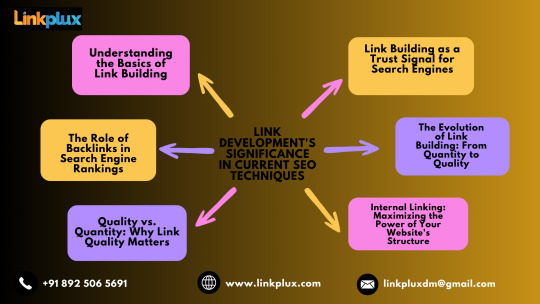
The Effect of External Links The authority and search engine optimization (SEO) of a website are greatly impacted by outbound links. You establish credibility and give users something of value when you connect to reliable sources. Additionally, outbound links can improve visibility and build partnerships. But it's important to strike a balance when it comes to incoming connections. In general, thoughtful outbound linking enhances SEO efforts by positioning your website as a useful resource.
Calculating Achievement It is essential to measure SEO accomplishment in order to comprehend efficacy and make wise selections. Important performance indicators include organic traffic, keyword ranks, and conversion rates. Data gathering and analysis are made easier by tools like Google Analytics and Search Console, which allow for optimization based on data. Maintaining success in organic search requires regular monitoring and analysis in order to adjust techniques to changing conditions.
In conclusion, link building is still essential to contemporary SEO tactics since it raises the visibility, authority, and ranks of websites. Long-term success requires embracing ethical standards and placing an emphasis on quality rather than quantity. Link building tactics must be adjusted to prioritize relevance and authority as search engines change. Online success mostly depends on comprehending the importance of link building and effectively incorporating it into search engine optimization (SEO) initiatives.
4 notes
·
View notes
Text
AI-Powered SEO Solutions: Transforming Digital Visibility in the UK
Search Engine Optimisation (SEO) has come a long way from keyword stuffing and basic backlinking. Today, with search engines becoming increasingly intelligent, businesses must adopt smarter, data-driven strategies to stay ahead. Enter AI-powered SEO solutions — a groundbreaking approach that’s reshaping how UK companies improve their online visibility, attract customers, and drive conversions.

What Are AI-Powered SEO Solutions?
AI-powered SEO refers to the integration of artificial intelligence and machine learning technologies into the SEO process. These tools can analyse large datasets, uncover patterns in user behaviour, and automate key optimisation tasks — all with greater speed and accuracy than traditional methods.
In the UK’s competitive online landscape, AI-driven SEO allows businesses to optimise their websites based on real-time data, deliver highly personalised user experiences, and adapt to algorithm changes more efficiently.
How AI is Changing SEO for UK Businesses
1. Smarter Keyword Research
AI tools can evaluate millions of search queries to identify high-performing keywords with less competition. Rather than simply relying on static keyword lists, AI-powered platforms recommend dynamic terms based on trends, user intent, and regional preferences — crucial for UK businesses targeting specific cities or counties.
2. Improved Content Optimisation
AI analyses how top-performing pages are structured, what questions they answer, and how they engage users. This allows UK marketers to craft SEO-friendly content that satisfies both search engines and human readers.
Tools powered by AI can suggest content improvements, evaluate readability, and ensure relevance — all while aligning with the tone expected by UK audiences.
3. Predictive SEO
One of the most exciting developments is predictive SEO, where AI forecasts future trends and recommends strategies in advance. This helps UK companies get ahead of their competitors by preparing content and campaigns before demand peaks.
4. Voice and Visual Search Optimisation
As voice search grows in popularity — especially among mobile users across the UK — AI plays a key role in helping websites adapt. From understanding natural language queries to optimising for featured snippets and image searches, AI is essential for modern SEO success.
5. Automated Site Audits and Technical Fixes
AI crawlers and audit tools can detect broken links, duplicate content, slow-loading pages, and mobile usability issues far quicker than manual checks. This is particularly useful for UK-based eCommerce sites or content-heavy platforms, ensuring a seamless user experience.
Why AI-Powered SEO Matters for the UK Market
The UK’s digital economy is among the most advanced in the world. With consumers turning to Google, Bing, and other search engines for nearly everything — from shopping and travel to local services — ranking well is critical.
AI-powered SEO offers benefits tailored to this fast-moving market:
Regional targeting: Tailor content for local cities like London, Birmingham, Manchester, or Glasgow.
User intent analysis: Understand how UK customers phrase queries and what they're really looking for.
Compliance and data handling: Ensure your strategies are aligned with UK data privacy laws and regulations (e.g. GDPR).
Challenges to Consider
While AI provides a powerful edge, it’s not a set-and-forget solution. It’s important to:
Combine AI insights with human creativity and industry knowledge.
Ensure ethical use of data and maintain transparency with users.
Choose the right platforms and tools that align with your business goals and budget.
Final Thought
As search engine algorithms grow more complex and customer behaviour evolves rapidly, UK businesses can no longer afford to rely solely on outdated SEO tactics. AI-powered SEO solutions offer a smarter, faster, and more adaptive way to boost your search presence and reach the right audience.
For businesses looking to stay ahead in the UK’s competitive digital space, Armada Internet offers cutting-edge, AI-enhanced SEO services designed to deliver measurable results. Let data and intelligence lead your next digital move.
0 notes
Text
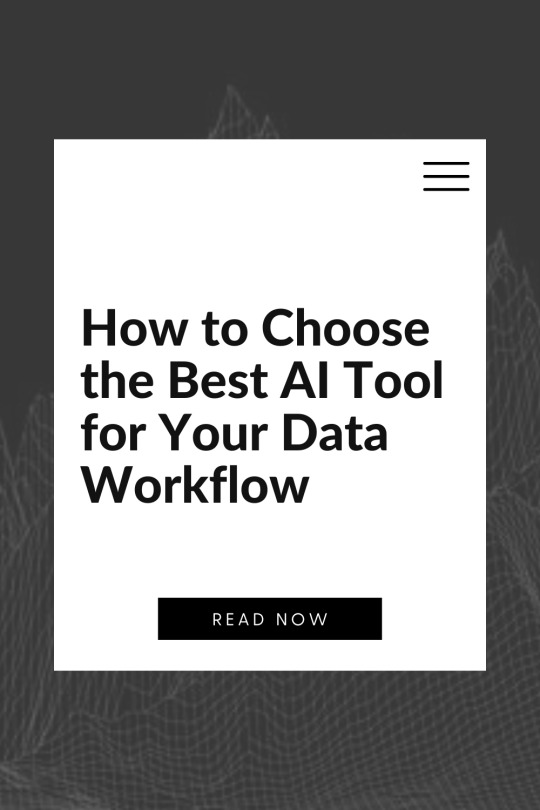
How to Choose the Best AI Tool for Your Data Workflow
AI isn’t just changing the way we work with data, it’s opening doors to entirely new possibilities. From streamlining everyday tasks to uncovering insights that were once out of reach, the right AI tools can make your data workflow smarter and more efficient. But with so many options out there, finding the one that fits can feel like searching for a needle in a haystack. That’s why taking the time to understand your needs and explore your options isn’t just smart, it’s essential.
In this guide, we’ll walk you through a proven, easy-to-remember decision-making framework: The D.A.T.A. Method: a 4-step process to help you confidently choose the AI tool that fits your workflow, team, and goals.

The D.A.T.A. Method: A Framework for Choosing AI Tools
The D.A.T.A. Method stands for:
Define your goals
Analyze your data needs
Test tools with real scenarios
Assess scalability and fit
Each step provides clarity and focus, helping you navigate a crowded market of AI platforms with confidence.
Step 1: Define Your Goals
Start by identifying the core problem you’re trying to solve. Without a clear purpose, it’s easy to be distracted by tools with impressive features but limited practical value for your needs.
Ask yourself:
What are you hoping to achieve with AI?
Are you focused on automating workflows, building predictive models, generating insights, or something else?
Who are the primary users: data scientists, analysts, or business stakeholders?
What decisions or processes will this tool support?
Having a well-defined objective will help narrow down your choices and align tool functionality with business impact.
Step 2: Analyze Your Data Needs
Different AI tools are designed for different types of data and use cases. Understanding the nature of your data is essential before selecting a platform.
Consider the following:
What types of data are you working with? (Structured, unstructured, text, image, time-series, etc.)
How is your data stored? (Cloud databases, spreadsheets, APIs, third-party platforms)
What is the size and volume of your data?
Do you need real-time processing capabilities, or is batch processing sufficient?
How clean or messy is your data?
For example, if you're analyzing large volumes of unstructured text data, an NLP-focused platform like MonkeyLearn or Hugging Face may be more appropriate than a traditional BI tool.
Step 3: Test Tools with Real Scenarios
Don’t rely solely on vendor claims or product demos. The best way to evaluate an AI tool is by putting it to work in your own environment.
Here’s how:
Use a free trial, sandbox environment, or open-source version of the tool.
Load a representative sample of your data.
Attempt a key task that reflects a typical use case in your workflow.
Assess the output, usability, and speed.
During testing, ask:
Is the setup process straightforward?
How intuitive is the user interface?
Can the tool deliver accurate, actionable results?
How easy is it to collaborate and share results?
This step ensures you're not just selecting a powerful tool, but one that your team can adopt and scale with minimal friction.
Step 4: Assess Scalability and Fit
Choosing a tool that meets your current needs is important, but so is planning for future growth. Consider how well a tool will scale with your team and data volume over time.
Evaluate:
Scalability: Can it handle larger datasets, more complex models, or multiple users?
Integration: Does it connect easily with your existing tech stack and data pipelines?
Collaboration: Can teams work together within the platform effectively?
Support: Is there a responsive support team, active user community, and comprehensive documentation?
Cost: Does the pricing model align with your budget and usage patterns?
A well-fitting AI tool should enhance (not hinder) your existing workflow and strategic roadmap.
“The best tools are the ones that solve real problems, not just the ones with the shiniest features.”
— Ben Lorica (Data scientist and AI conference organizer)
Categories of AI Tools to Explore
To help narrow your search, here’s an overview of AI tool categories commonly used in data workflows:
Data Preparation and Cleaning
Trifacta
Alteryx
DataRobot
Machine Learning Platforms
Google Cloud AI Platform
Azure ML Studio
H2O.ai
Business Intelligence and Visualization
Tableau – Enterprise-grade dashboards and visual analytics.
Power BI – Microsoft’s comprehensive business analytics suite.
ThoughtSpot – Search-driven analytics and natural language querying.
DataPeak by Factr – A next-generation AI assistant that’s ideal for teams looking to enhance decision-making with minimal manual querying.
AI Automation and Workflow Tools
UiPath
Automation Anywhere
Zapier (AI integrations)
Data Integration and ETL
Talend
Fivetran
Apache NiFi
Use the D.A.T.A. Method to determine which combination of these tools best supports your goals, data structure, and team workflows.
AI Tool Selection Checklist
Here’s a practical checklist to guide your evaluation process:
Have you clearly defined your use case and goals?
Do you understand your data’s structure, source, and quality?
Have you tested the tool with a real-world task?
Can the tool scale with your team and data needs?
Is the pricing model sustainable and aligned with your usage?
Does it integrate smoothly into your existing workflow?
Is support readily available?
Selecting the right AI tool is not about chasing the newest technology, it’s about aligning the tool with your specific needs, goals, and data ecosystem. The D.A.T.A. Method offers a simple, repeatable way to bring structure and strategy to your decision-making process.
With a thoughtful approach, you can cut through the noise, avoid common pitfalls, and choose a solution that genuinely enhances your workflow. The perfect AI tool isn’t the one with the most features, it’s the one that fits your needs today and grows with you tomorrow.
Learn more about DataPeak:
#datapeak#factr#saas#technology#agentic ai#artificial intelligence#machine learning#ai#ai-driven business solutions#machine learning for workflow#digitaltools#digital technology#digital trends#datadrivendecisions#dataanalytics#data driven decision making#agentic#ai solutions for data driven decision making#ai business tools#aiinnovation#ai platform for business process automation#ai business solutions
0 notes
Text
The Impact of 3D Modeling for 3D Printing on Custom Manufacturing

Impact of 3D Modeling for 3D Printing
In today's fast-paced and hyper-personalized world, businesses and consumers increasingly seek custom-made products tailored to their unique needs. At the core of this shift lies the powerful combination of 3D modeling for 3D printing and custom manufacturing. This pairing transforms traditional production processes and drives innovation across various industries—from medical devices and consumer products to aerospace and architecture.
What is 3D Modeling for 3D Printing?
3D modeling for 3D printing involves creating a digital representation of a physical object that can be directly converted into a printable format, usually an STL or OBJ file. These models are created using professional 3D Modeling Services and are designed with precision to meet the functional, aesthetic, and mechanical requirements of the final product.
By leveraging 3D product modeling services, manufacturers can develop complex geometries, internal structures, and intricate details that would be impossible or too expensive to achieve through traditional methods.
The Rise of Custom Manufacturing
Thanks to 3D Modeling for 3D Printing, companies can now create prototypes, test ideas, and manufacture small batches of custom products with speed and accuracy.
How 3D Modeling Empowers Customization
1. Rapid Prototyping
One of the most significant impacts of 3D Model Augmented Reality is in rapid prototyping. A 3D model maker for a 3D printer can quickly convert a concept into a tangible prototype. This enables designers and engineers to identify flaws early, make necessary adjustments, and improve product quality without incurring high tooling costs.
2. Personalization at Scale
With the help of 3D modeling services, manufacturers can offer customized products at scale. Whether it’s personalized dental aligners, custom phone cases, or ergonomically designed handles, 3D product modeling services make it possible to adapt each product to the specific measurements or preferences of an individual customer.
3. Enhanced Product Complexity
However, 3D Modeling for 3D Printing removes these limitations. Designers can now create highly complex and lightweight structures—such as lattice supports or internal channels—without additional production steps.
Integration with AR and VR Technologies
The impact of 3D modeling extends beyond physical products. Emerging technologies like 3D Model Augmented Reality (AR) and virtual reality (VR) are redefining how models are visualized, tested, and even marketed.
AR 3D Modeling for Visualization
AR 3D Modeling enables businesses to visualize digital objects in the real world before they’re manufactured. This helps clients understand product dimensions, placement, and aesthetics with greater clarity. For instance, using AR Product Visualization, a furniture manufacturer can show how a custom-made table would look in a customer’s living room before it is printed.
VR 3D Modeling for Simulation
On the other hand, VR 3D Modeling allows designers to immerse themselves in a virtual environment to test their designs. Whether it’s evaluating the usability of a custom vehicle dashboard or the ergonomics of a tool handle, Virtual Reality 3D Modeling provides a hands-on approach to refining product designs before printing.
Applications of 3D Modeling for 3D Printing in Custom Manufacturing
1. Healthcare & Medical Devices
From prosthetics to dental implants, the healthcare sector has embraced 3D modeling for 3D printing to provide customized solutions for patients. Using advanced 3D product modeling services, prosthetic limbs can be tailored to an individual's anatomy, ensuring better comfort and functionality.
2. Automotive & Aerospace
High-performance industries like automotive and aerospace rely on 3D Model Maker for 3D Printer to create lightweight yet durable parts. This includes everything from custom brackets and housings to functional interior parts designed for specific models or pilots.
3. Consumer Products
In fashion, jewelry, and home decor, 3D Modeling Services empower designers to offer one-of-a-kind products. AR features also enhance the shopping experience. For example, AR Product Visualization allows customers to virtually “try on” glasses or see how a custom ring would look on their hand.
4. Industrial Manufacturing
In industrial settings, custom jigs, fixtures, and machine parts can be designed using 3D modeling services to match specific production lines or machinery.
3D Modeling for 3D Printing
Cost Efficiency
Instead of investing in expensive molds, they can directly print parts as needed, even in small quantities.
Speed to Market
The design-to-production cycle is significantly shortened. Changes can be made instantly in the 3D model and printed on the same day, ensuring faster product development and launch.
Sustainability
Custom manufacturing using 3D product modeling services produces less waste compared to traditional subtractive methods. Materials are only used where needed, and designs can be optimized for minimal environmental impact.
Design Flexibility
3D Modeling Services offer unprecedented design freedom. Whether for organic shapes, custom engravings, or complex moving parts, the possibilities are virtually limitless.
The Role of Professional 3D Modeling Services
While 3D printing hardware is more accessible than ever, the quality of output still depends on the quality of the digital model. That's why professional 3D modeling services play a vital role in custom manufacturing. These services ensure models are designed with the appropriate tolerances, wall thickness, and structural integrity needed for specific materials and 3D printing methods.
Whether you need a 3D Model Maker for 3D Printer, an expert in AR 3D Modeling, or a specialist in VR 3D Modeling, partnering with a skilled team can dramatically improve the performance, accuracy, and marketability of your custom product.
Future Outlook
As 3D product modeling services continue to evolve and integrate AI-driven automation, the process of turning ideas into personalized products will become faster, cheaper, and more intelligent.
We are also seeing growth in cloud-based platforms where users can design, visualize, and order custom products from the comfort of their homes. With real-time AR Product Visualization and Virtual Reality 3D Modeling, the entire production lifecycle—from design to delivery—is being redefined.
Conclusion
3D Modeling for 3D Printing is not just a technological trend—it is a foundational element driving the future of custom manufacturing. From rapid prototyping and personalized medical devices to immersive AR/VR product visualization, the impact of this digital-to-physical workflow is profound and far-reaching.
Businesses looking to stay ahead in a competitive marketplace must embrace 3D Modeling Services, explore AR 3D Modeling for consumer engagement, and tap into 3D product modeling services for tailored production. Whether you're a startup, a global manufacturer, or a creative entrepreneur, the fusion of 3D modeling and 3D printing offers a gateway to limitless customization.
#3D Modeling Services#AR 3D Modeling#3D product modeling services#3D Model Augmented Reality#AR Product Visualization#VR 3D Modeling#Virtual Reality 3D Modeling#3D Modeling for 3D Printing#3D Model Maker for 3D Printer
0 notes
Text
Swift Fixes for Windscreen Damage
Addressing Windscreen Issues Promptly
A cracked or chipped windscreen poses more than an aesthetic problem; it compromises driver safety and vehicle integrity. Quick action is crucial to prevent small damages from escalating into major hazards. Mobile windscreen repair services provide an innovative solution, delivering professional repairs directly to the driver’s location. This on-the-go approach eliminates the inconvenience of visiting a repair shop, making it ideal for those with demanding schedules.
Technicians arrive with specialized equipment to address chips or minor cracks efficiently, often completing the job in under an hour. This service caters to drivers needing immediate fixes, whether at home, work, or on the road, ensuring minimal disruption to their day. By offering rapid and reliable repairs, these mobile solutions restore safety and functionality with unmatched convenience.
The Science of Windshield Restoration
Repairing a damaged windscreen is a precise process that restores both appearance and strength. Windshield repair involves injecting a high-quality resin into the affected area to seal cracks and prevent further spreading. This technique not only enhances visibility by filling in damage but also reinforces the glass, maintaining its structural role in the vehicle’s safety system.
The process is most effective for small chips or cracks caused by debris or minor impacts. Trained technicians evaluate the damage to ensure repair is a viable option, adhering to safety standards. This method extends the windscreen’s lifespan, often delaying or eliminating the need for costly replacements while delivering near-invisible results that preserve the vehicle’s aesthetic.
Unparalleled Convenience for Drivers
Mobile repair services redefine convenience by bringing expertise directly to the customer. Whether parked at an office, home, or shopping center, drivers can have their windscreens repaired without rearranging their plans. This flexibility is a game-changer for busy professionals, parents, or fleet managers who need to keep vehicles operational without downtime.
The efficiency of these repairs matches their convenience, with technicians using advanced tools to deliver durable results quickly. High-strength resins and precise application ensure the windscreen is ready for use shortly after the repair, allowing drivers to return to the road with confidence. This seamless service model prioritizes customer ease, making vehicle maintenance stress-free.
Saving Money and the Environment
Repairing a windscreen is significantly more cost-effective than replacing it, offering savings that appeal to budget-conscious drivers. Mobile services further reduce expenses by eliminating travel costs or the need for alternative transportation during repairs. The process preserves the original glass, avoiding additional charges for new installations or recalibrating vehicle safety systems.
Environmentally, repairing rather than replacing supports sustainability by reducing waste. Discarded windscreens often end up in landfills due to limited recycling options, but repairs extend their usability, conserving resources. This eco-friendly approach aligns with growing environmental awareness, allowing drivers to make responsible choices without sacrificing quality or safety.
Prioritizing Vehicle Safety
A damaged windscreen undermines a vehicle’s safety, reducing visibility and weakening its structural integrity during collisions. Professional repairs address these risks by restoring the glass’s strength and clarity, ensuring it meets safety regulations. Mobile technicians use industry-standard techniques to deliver reliable results, giving drivers peace of mind on the road.
Timely repairs prevent minor chips from developing into extensive cracks that require replacement, maintaining the windscreen’s protective role. Regular maintenance, such as addressing damage early, ensures long-term safety for drivers and passengers. By choosing professional repair services, vehicle owners safeguard their journeys, prioritizing security in every drive.
Versatile Solutions for All Vehicles
Mobile windscreen repair services are designed to accommodate a wide range of vehicles and scenarios. From personal cars to commercial vans and fleet trucks, technicians can handle various windscreen types and damage sizes, provided they fall within repairable limits. This versatility makes the service invaluable for individual drivers and businesses alike, ensuring vehicles remain operational.
The adaptability extends to different settings, with repairs possible in urban or rural locations, catering to diverse customer needs. Fleet operators benefit from on-site services that minimize downtime, while everyday drivers appreciate the convenience of home-based fixes. This broad applicability underscores the value of mobile repairs as a universal solution for windscreen maintenance.
A Modern Approach to Vehicle Care
Mobile windscreen repair and professional restoration techniques represent a forward-thinking approach to automotive maintenance, blending convenience, affordability, and safety. These services empower drivers to address damage swiftly, preserving their windscreens and avoiding unnecessary replacements. By delivering expertise directly to customers, they transform how vehicle care is accessed, prioritizing efficiency and ease.
As the demand for practical, eco-conscious solutions grows, these repair services are set to redefine industry standards. They provide a pathway to maintain vehicle safety and aesthetics without financial or logistical burdens, ensuring drivers navigate with confidence. From rapid fixes to sustainable practices, mobile windscreen repair paves the way for a future where vehicle maintenance is accessible, reliable, and environmentally responsible.
0 notes
Text
The Future of Web Development: Embracing Accessible Website Design

As the internet becomes an essential part of everyday life, creating websites that everyone can use is more important than ever. Accessible website design is no longer just a nice-to-have feature; it’s a fundamental aspect of modern web development that ensures inclusivity, legal compliance, and enhanced user experience.
In this article, we explore why accessible website design is shaping the future of web development and how businesses can benefit by embracing these practices today.
What Is Accessible Website Design?
Accessible website design refers to building and designing websites that can be easily used by people of all abilities and disabilities. This includes individuals with visual, auditory, motor, and cognitive impairments. The goal is to remove barriers that prevent users from interacting with digital content effectively.
Accessible websites follow guidelines such as the Web Content Accessibility Guidelines (WCAG), which provide a framework to ensure websites are perceivable, operable, understandable, and robust for all users.
Why Accessible Website Design Is the Future
1. Growing Demand for Inclusivity
With over 1 billion people worldwide experiencing some form of disability, the need for inclusive digital spaces is undeniable. Businesses and organizations are recognizing the importance of catering to this diverse audience, fostering equality and social responsibility.
2. Legal Requirements and Compliance
Many countries have enacted laws requiring websites to meet accessibility standards, including the Americans with Disabilities Act (ADA) in the U.S. and the Accessibility for Ontarians with Disabilities Act (AODA) in Canada. Non-compliance can result in legal penalties and reputational damage.
3. Improved User Experience for Everyone
Accessible design enhances usability for all visitors, not just those with disabilities. Features like better navigation, clearer content structure, and adaptable interfaces improve overall satisfaction and engagement.
4. SEO Benefits
Search engines favor websites that are well-structured and user-friendly. Many accessibility best practices, such as proper use of headings and alt text for images, also contribute to higher search rankings.
5. Technological Advancements
The future of web development involves innovative technologies like AI, voice recognition, and augmented reality. Accessible design ensures that these technologies can be utilized by everyone, expanding the possibilities of digital interaction.
Key Principles of Accessible Website Design
Perceivable: Information must be presented in ways users can perceive, such as providing text alternatives for images and captions for videos.
Operable: Users must be able to navigate and operate the website using different input methods, including keyboard-only navigation.
Understandable: Content should be clear and simple to understand, with consistent navigation and predictable functionality.
Robust: Websites must be compatible with current and future technologies, including assistive devices like screen readers.
How Businesses Can Embrace Accessible Website Design
Conduct Accessibility Audits: Evaluate your current website to identify and fix accessibility barriers.
Incorporate Accessibility in Development: Make accessibility a core part of your design and development process from the start.
Train Your Team: Educate designers, developers, and content creators on accessibility standards and best practices.
Engage Users with Disabilities: Involve people with disabilities in testing and feedback to ensure real-world usability.
Stay Updated: Keep up with evolving guidelines, technologies, and legal requirements.
Final Thoughts
Embracing AODA web design is more than a legal obligation—it’s a commitment to inclusivity, innovation, and superior user experience. As web development continues to evolve, accessibility will remain a cornerstone of successful digital strategies.
By prioritizing accessibility, businesses not only comply with regulations but also tap into a wider audience, improve SEO, and foster a positive brand reputation. The future of the web is accessible—and your website should be, too.
0 notes
Text
Why each eCommerce website wishes a CRO Audit: Key to better Conversion fees
Optimizing an eCommerce internet site requires various efforts depending at the website's structure, product offerings, and target audience. whilst a few web sites can advantage from small, honest modifications like repositioning a button, others may also require more complex strategies, inclusive of enhancing client faith through lengthy-term campaigns and internet site upgrades. Professional hire shopify development services to build, scale, and optimize your eCommerce store.
A minor adjustment to how products are presented can occasionally deliver measurable outcomes. then again, significant upgrades often require ongoing attempt and experimentation. however, figuring out the most powerful placement for social evidence worried multiple rounds of checking out. some experiments produced small gains, even as others had no effect or maybe caused declines. the key used to be patience and adaptableness.
comparing available tools and techniques is imperative to developing a a success eCommerce conversion fee optimization (CRO) method. two widely used approaches are the CRO Audit and the non-stop testing software.
what is a Conversion Audit?
the usage of assumptions rather than statistics to remedy troubles with website usability is like being caught within the jar and trying to study the label. The ache point for businesses with custom-constructed eCommerce web sites is the lack of ability to return to the first-time person angle.
appreciation customers' behavior and navigation in the course of a internet site is a key factor while speaking about eCommerce Conversion price. Auditing the conversion manner of a site is one of the largest elements whilst trying to become aware of the areas of difficulty to discover the internet site's performance. Empower your online business with our result-driven Shopify Development Service.
A CRO, or conversion audit, is the in-depth assessment of the client’s revel in on a selected internet site. the main goal is to pick out technical or usability troubles that could damage the site’s effectiveness in changing site visitors into clients.
this is a step-by means of-step assessment of the customers' interaction with the site, mapping out a complete usage situation at the same time as evaluating the site log documents and different overall performance statistics. via looking at the global patron angle and the fundamental conversion metrics, the conversion audit factors out the problems at the way to conversion and can assist to enhance web site overall performance.
1. CRO Audit
A CRO audit is a one-time carrier designed to perceive vast possibilities for enhancing website overall performance. It’s a price-effective answer that follows a structured method.
appreciation the commercial enterprise and its dreams
engaging in a detailed web page audit
presenting actionable recommendations
Reviewing and approving changes for implementation
The audit examines every web page template, from the homepage to the checkout web page, the usage of metrics and exceptional practices hooked up with the aid of industry professionals. Key areas of awareness include:
soar charges and cart abandonment
consumer experience (UX) layout
Calls-to-movement (CTAs)
Chatbot effectiveness
Product descriptions and pics
Checkout procedures
patron opinions, pop-ups, and banners
After finishing the audit, businesses get hold of a tailored listing of suggestions. even as the system doesn’t encompass A/B checking out, it’s perfect for:
corporations with low conversion costs
companies that haven’t undergone an outside CRO audit before
websites with constrained traffic that don’t justify ongoing CRO investments
This method works nicely for small- to medium-sized eCommerce companies or larger groups with in-residence teams capable of implementing and checking out hints. they can improve their eCommerce Conversion rate with a comprehensive CRO audit package deal.
Why each eCommerce internet site needs a CRO Audit?
eCommerce CRO occasionally gets a awful rap because approaches consciousness on pressuring clients into purchases in place of definitely enhancing the website and product. however, when done correctly, CRO can create sizable benefits for both organizations and their customers by enhancing fee and improving the consumer experience.
right here are six key reasons why CRO must be a priority.
pinnacle motives Why CRO need to Be a concern
1. Know Your customers
understanding your clients and their problems is the inspiration of assembly their needs. CRO gives a thanks to get into the person’s shoes and look at all the contact points of their client adventure and the product itself. while you perform assessments which include A/B, you may discover important information concerning your target audience's goals. vacationer feedback equipment and questionnaires, surveys, and recordings of actual sessions can give you an idea of what strategies are powerful and which are not on the subject of internet site Optimization that connects along with your target market.
2. Better Lifetime cost
in case you’re already investing money in advertising and marketing and marketing, CRO gives you the best return on funding. in contrast to different varieties of marketing that are seeking for to get as many humans to visit your website or make a purchase, it goals to transform that traffic into customers, consequently stretching your available assets. whilst you awareness on streamlining the navigation, coordinating the CTA’s vicinity with the person’s cause, and removing choices which could sluggish the user down, you beautify the simple parameters of conversion costs and ROI at the used advertising.
3. Maximize Your current site visitors
it's far one element to draw extra humans to a internet site, however at other times it's miles all approximately the way to quantify the experience of the prevailing site visitors. this means that through CRO, you could acquire more via internet site Optimization by means of improving the retention of customers and taking gain of the present day advertising and marketing and seo techniques. A heat map may be useful right here to get a clean photograph of wherein precisely site visitors and customers are in all likelihood to spend greater in their time to your website online. This way, the fine traffic you are already attracting is optimally applied.
4. Increase the fee of a customer
It need to be referred to that CRO isn’t solely approximately conversion acquisition however also about conversion retention. in addition, you may get statistics on specific customers and use it to build up their loyalty, for example, by means of supplying reminders of the products that had been bought before to seize the repeat-customers marketplace.
understanding their clients also permits you to create appropriate experiences to persuade them to any appropriate product/provider wished all through their lifetime, increasing consumer lifetime price.
5. Enhance the user experience (UX)
Conversion optimization is an interlinked process with usability, this means that that the more targeted you grow to be on changing humans, the extra usable your website online becomes. CRO allows you to decide which stage inside the customer’s glide is hard to conquer, whether it's far nonintuitive navigation or a complex name to motion, and improve on it.
while you optimize your website with usability and accessibility in idea, each web page will become exciting, which is right for business and appropriate for all, from first-time visitors to the prepared-to-consult.
6. Boost logo reputation and Product revel in (PX)
CRO isn’t just about pushing income; it’s approximately displaying clients you care about their usual experience. Refining the consumer adventure builds belief and demonstrates that your enterprise prioritizes fee over tough-selling techniques.
constant branding, seamless navigation, and useful functions make clients sense confident in your website online, developing a high-quality influence they’ll understand. happy clients are likelier to advise your enterprise to others, amplifying your efforts and developing your reputation.
Do you want a complete CRO (Conversion price Optimization) record to analyze your internet site's overall performance and pick out areas for improvement to boost your conversion prices?
While is the proper Time to carry out a CRO Audit for an eCommerce website?
A conversion rate optimization (CRO) audit may be completed at any time, but to maximize performance and achieve meaningful consequences, it’s great to focus on these key moments:
A few Months After launch
After placing into practice a internet site, there is often a period whilst all the enthusiasts of the specific company or emblem attend to it regularly. but, this early engagement couldn't be taken as an correct illustration of users’ subsequent behavior. Having released a CRO audit several months before the prevailing time is proper because it displays any new generally existing usability or conversion troubles of a site after its release, thereby imparting a better assessment of its long-time period overall performance.
When consumer developments Shift
A CRO audit can be beneficial in case you see a shift of 10% towards making greater actual paying clients or if there’s a shift within the opposite path. The audit can discover reasons for declining conversions or the range's user experience problem. For in addition boom, the studies on enhancing the experience can retain in order that the web site corresponds to user expectations and fulfills the supposed purpose.
How a CRO Audit will let you enhance Your Conversion prices?
to improve the conversion rates of a internet site, a CRO or Conversion fee Optimization audit is essential. An audit with CRO permits you to apprehend whilst and where leads leave your web page and which components of the website want to be tweaked to inspire extra customers to engage in particular behaviors like buying your products or subscribing to your e-newsletter. This outcomes in an better total user experience and an improved conversion fee.
1. Pick out Friction points
A CRO audit is going deeper than looking on the behaviors to apprehend the glide of the internet site and discover the moments that create hurdles and confusion. these irritations can deter customers from the method of changing. Such troubles can be identified, and you can make imperative amendments to beautify the drift and the character of the conversion funnel.
2. Information-driven Insights
one of the key blessings of a CRO audit is that it gives multi-layered data on a consumer’s behavior when she or he is to your internet site. This permits you to cognizance on designing your web site and choosing your content material, as well as your CTAs, round what works fine amongst the target audience in phrases of optimization.
3. Improved consumer revel in
A CRO audit's cause and result is to optimize a tourist's enjoy to your website. This method of CRO audit permits one to decide the particular regions that create frustration or confusion, making the format and capability choicest. As you understand, a extra streamlined and natural revel in with the web site convinces the customers to finalize the moves they got here to the website for, be it buying a product or signing up for a newsletter.
4. Focused Optimization
CRO audit enables the optimizer now not only spend adequate efforts at practicing changes however additionally target the ones factors that influence conversions most importantly. this case is clear in the volume to which CRO audit oversees the development of the touchdown pages, the manipulation of paperwork, and get in touch with-to-movement buttons, among different functions, to make them more attentive to achieving centered achievements.
5. Check and Iterate
it's been recognized that the ideas generated from this type of audit are ideal for destiny ongoing optimization. With the records in hand, you may release A/B exams and evaluate the modifications within the essential internet site factors. they also enable additional exceptional-tuning of the site and, in widespread, make it viable to growth the conversion rate constantly.
internet site Optimization the usage of statistics-pushed adjustments to improve Conversion costs
What a CRO Audit usually includes
an intensive CRO audit covers numerous essential factors of your internet site’s performance:
Analysis of consumer behavior
studying user behavior helps you step into the shoes of your site visitors. If no longer vocalized, it reveals their ache, together with a difficult navigation menu, an inactive button, or misplaced content. Such information lets you select optimum site layouts, designs, and functions.
as an example, if the heatmap demonstrates that maximum visitors pass by your primary name-To-motion, you may try diverse techniques, including enlarging the button or converting its colour or position on the web page. If one makes use of clickstream statistics and realizes it results in leaving behind a selected shape, you could reduce the number of structure fields or consist of instructions that guide the consumer on the way to go through it. It allows you to expand a web platform that well reflects your visitors’ perception of interactivity and that may lead the person in the right route in the direction of purchase.
considering optimization is focused on how users use your internet site, step one is usually to realize users’ behavior pleasant. but, via heat maps, click on-circulate evaluation, and scroll map evaluation, a CRO audit indicates you regions wherein visitors have interaction your website, what they be aware of, and in which they both disengage or are probable to be challenged.
Heatmaps are tools in UX precedence that map out how customers engage with their pages via mouse, scroll, and moves.
users’ clickstream records is a sequential view of customers' actions on a website. It seems like seeing their voyage – how they arrived in your web page, the trail they take, and wherein they are no longer visible. This statistics lets you apprehend whether or not customers progress linearly on your conversions or spend most of their time in a single section. for example, if many customers depart at some point of checkout, you may look at that page and find out what problems save you them from continuing their buying technique. Scroll depth tracking exhibits how some distance down a web page visitors scroll, supplying insights into how correctly your content material engages them. If users prevent scrolling earlier than achieving key information or CTAs, it is able to suggest your content material isn’t compelling adequate or quintessential elements are buried too far down the page. by way of reading scroll information, you may regulate content placement to make sure site visitors see critical statistics sooner, retaining them engaged and using them closer to movement.
Evaluate of touchdown Pages
domestic pages or touchdown pages are the entrance in your website; consequently, they are crucial for conversion charge. usually, it must draw the vacationer’s interest and cause them to do some thing – buy some thing, join up for a e-newsletter, or down load a useful resource. A CRO audit can study each part of these pages to assure that the most percentage of the visitors is transformed into clients.
therefore, each touchdown web page’s graphic sketch breaks a vast amount of floor in how users method the emblem and content. A CRO audit tests if the plan is right, appears less homemade, and corresponds on your brand. for example, a few layouts may be puzzling as a result of crowding, whilst missing emblem concord may additionally result in developing consumer skepticism. appropriate use of section headings, good spacing, and right referencing of photographs do help decorate the extent of interest.
Your target market has to discover the records on your landing pages applicable and understand the benefits of receiving it from you. overall, a CRO audit determines whether or not headlines and subheadings are being used and whether or not the reproduction within the frame is succinct yet persuasive.
The content material need to meet your target market’s needs, which means that it has to wow them with aspects of their lamented troubles and gift samples and methods to solve them. It additionally suggests potential site visitors will probable use their browser's returned button if the message is ambiguous or cluttered. Likewise, the tone and the type of language used should be with the aid of your brand photograph whilst on the same time being popular with the expectations of the community.
CTAs are constantly essential on any touchdown web page for the reason that they manual users closer to the supposed path of action. Cro audit assessments your name to motion to determine how clear and visible they're and wherein they're placed. Are they visible, and do they stand out? Do they hire a name to movements that urge the users to click on?
as an instance, words like “click on right here” or “subscribe” may fit, however words like “click on here to get 20% Off” will paintings even higher. The audit may additionally recommend changing the buttons' coloration, length, or position to decide which choice is great for the internet site.
A easy and logical person flow keeps traffic engaged and reduces jump prices. A CRO audit evaluates how properly your touchdown pages guide users via the conversion adventure. Are visitors capable of discover the facts they need fast? Is the subsequent step inside the process clear and intuitive?
Evaluation of CRO Audit
for example, customers may additionally get bored and depart in the event that they scroll without end to locate a form or navigate more than one pages to finish a easy action. Simplifying navigation, lowering useless steps, and ensuring a clean course to conversion could make a huge distinction.
The variety and form of fields in a form considerably impact user enjoy. A CRO audit assesses whether your shape solely requires the quintessential statistics to finish the mission.
Streamlining your forms by disposing of useless fields can reduce friction and encourage of entirety.
moreover, the audit assessments for the proper use of optional and obligatory fields. Marking mandatory fields actually and the usage of asterisks or different indicators guarantees users recognise exactly what's required without confusion.
clean, concise labels and commands guide customers thru a form. A CRO audit critiques whether or not form labels are without problems understood and located efficiently. for example, labels placed without delay above or inner fields can make the shape greater intuitive and reduce cognitive load.
you could get expert help to conduct a detailed CRO (Conversion rate Optimization) audit and discover opportunities to decorate your website’s overall performance and maximize conversions.
Cell Optimization
one of the primary desires of cell optimization is to create clean forms to interact with on smaller displays. A CRO audit assessments that form fields are as it should be sized, making sure customers can faucet on them without by accident clicking nearby elements. Spacing between fields is likewise evaluated to save you overcrowding and offer a easy, person-pleasant graph. cell users gain from tailor-made enter methods that make filling out paperwork faster and easier. A properly-optimized mobile form fits evidently inside the screen length, eliminating the need for users to zoom in or scroll horizontally. A CRO audit evaluates how bureaucracy appear across various devices and display orientations, making sure they stay fully functional and legible no matter the user’s screen size.
The position and diagram of the submit button are necessary for cellular users. A CRO audit exams that the buttons are:
massive ample to faucet easily.
genuinely categorized with movement-driven text like “sign on” or “location Order.”
positioned in an accessible area, which include the lowest of the display, to avoid the need for immoderate scrolling.
mobile customers expect speedy-loading pages. A CRO audit evaluates your website online’s load time on cellular devices, as delays can frustrate users and lead to abandonment. techniques like compressing images, minimizing JavaScript, and allowing browser caching can enhance cell overall performance.
The cell revel in varies drastically throughout distinct gadgets and browsers. A CRO audit ensures that your site is tested on popular devices (e.g., iPhones, Android phones, drugs) and browsers to discover and resolve compatibility issues.
innovative net App (PWA) functions for eCommerce websites can similarly beautify the cell experience. A CRO audit would possibly propose imposing offline get right of entry to, push notifications, and app-like navigation to cater to cell-first customers.
grasp where and why users abandon paperwork is essential to optimizing your website’s conversion funnel. A CRO audit leverages superior analytics gear to pinpoint the precise ranges within the shape-filling manner where users drop off. through identifying these trouble regions, you may put in force centered answers to enhance of entirety quotes and enhance the general consumer revel in.
Analytics gear like Google Analytics, Hotjar, or crazy Egg can offer specific insights into person conduct as they navigate your bureaucracy.
Technical overall performance Audit
Your internet site's technical overall performance is pivotal in handing over a continuing consumer enjoy. gradual load instances, system faults, and errors can frustrate visitors and considerably damage conversion charges. A CRO audit very well evaluates these technical elements to make sure a quick, clean, and reliable enjoy.
areas of Technical evaluation
Page Load speed
gradual-loading pages can result in higher soar charges and decrease consumer delight. studies suggests that even a one-2nd postpone in load time can lower conversions. A CRO audit makes use of tools like Google PageSpeed Insights or GTmetrix to assess load times and discover factors that cause delays, including unoptimized images, immoderate JavaScript, or big CSS documents.
Mobile performance
With tremendous visitors coming from mobile devices, ensuring your web site features easily on smaller displays is essential. The audit evaluates responsiveness, contact-pleasant buttons, fast-loading mobile pages (e.g., AMP), and whether the web page plan adapts seamlessly to extraordinary gadgets.
Error Decision
broken links, server errors (e.g., 404 or five hundred errors), or incomplete forms can derail user journeys and erode belief. The audit identifies and resolves these problems to make sure users encounter a smooth, uninterrupted revel in.
Center net Vitals
core web Vitals, together with metrics like largest Contentful Paint (LCP), First input put off (FID), and Cumulative layout Shift (CLS), without delay impact search engine optimization scores and person pleasure. A CRO audit measures these vitals and suggests optimizations to enhance performance.
Website hosting and Server Reliability
common downtime or sluggish server responses can deter traffic and reduce belief. The audit evaluations server performance, uptime charges, and scalability all through height site visitors.
Optimized Media content material
outstanding snap shots and films increase the user experience. nonetheless, they could appreciably slow down a site if not optimized—the audit checks for proper photograph compression, lazy loading, and video optimization strategies.
Also Read : ChatGPT Ecommerce Is right here: How AI Is converting on line buying
How White Label services reduce Overhead & increase revenue for organizations
#hire shopify experts#shopify experts india#shopify developers for hire#white label shopify developers#white label shopify website development
0 notes
Text
Cost Breakdown: How Much Does a Pool Heat Pump Really Save?
Introduction to the Value of a Pool Heat Pump
Heating a swimming pool can be one of the most energy-intensive aspects of pool ownership. Traditional systems, while effective, often lead to substantial utility bills. Enter the pool heat pump — a smart alternative that promises efficiency and long-term cost savings. Pool heat pumps harness ambient air to heat pool water, making them an energy-efficient solution. But how much does a pool heat pump really save when all costs are laid out? This article breaks down the numbers to offer a clear picture of the economic benefits tied to choosing a pool heat pump.

Initial Investment vs. Long-Term Efficiency
Installing a pool heat pump usually involves a higher upfront cost compared to other heating methods. On average, the price for purchase and professional installation ranges between $2,500 and $5,000 depending on the unit's size and installation complexity. While this may seem steep initially, the true value lies in what follows: dramatically lower operating costs.
Electric resistance heaters and gas heaters consume more energy and cost more per hour of operation. A pool heat pump, in contrast, typically uses only a fraction of the electricity because it transfers heat rather than generating it from scratch. This translates into monthly utility savings that quickly add up.
Monthly Operating Costs: Comparing the Numbers
Electric resistance heaters can cost between $500 and $600 monthly to maintain optimal pool temperatures. Gas heaters aren't far behind, averaging $300 to $500 monthly, depending on usage and fuel prices. In stark contrast, a pool heat pump typically incurs monthly costs ranging from $50 to $150. That’s an average savings of up to 70% when compared to traditional systems.
These savings become even more apparent over time. Assuming an average swimming season of six months, a homeowner could save anywhere from $1,200 to $2,700 annually by switching to a pool heat pump.
Energy Efficiency and Performance Metrics
One of the most important metrics when evaluating pool heating systems is the Coefficient of Performance (COP). A higher COP means greater efficiency. Pool heat pumps usually boast a COP between 5.0 and 7.0, meaning they produce five to seven units of heat for every unit of electricity consumed. By comparison, electric resistance heaters have a COP of 1.0, and gas heaters average around 0.8 to 1.2. This substantial gap in performance highlights the efficiency advantage of a pool heat pump.
In warm climates, where air temperatures remain favorable year-round, the efficiency of pool heat pumps is further enhanced. Even in cooler regions, modern models are equipped to maintain high efficiency in ambient temperatures as low as 50°F.
Maintenance and Lifespan: More Ways to Save
Pool heat pumps not only offer monthly savings but also require minimal maintenance. Routine checks and occasional cleaning are typically all that’s needed to keep the system running efficiently. There are no burners or internal combustion elements that wear out quickly, as seen in gas heaters.
The average lifespan of a pool heat pump ranges from 10 to 20 years when properly maintained. This long service life adds even more value. In contrast, gas heaters often need replacement within 5 to 10 years. Fewer replacements over time mean reduced long-term expenses and fewer disruptions in heating.
Climate and Usage: Impact on Savings
A pool heat pump performs best in areas where the air temperature stays moderate to warm. The warmer the air, the less energy the system requires to transfer heat into the pool. For homeowners in southern regions or coastal states, the cost-saving benefits are significantly magnified due to optimal operating conditions nearly year-round.
Even in northern climates, advancements in technology have extended the usability of pool heat pumps into shoulder seasons like early spring and late fall. While slightly more power may be needed in cooler temperatures, the savings compared to gas or electric resistance heating still hold strong.
Return on Investment: When Do the Savings Add Up?
On average, a pool heat pump pays for itself within 2 to 5 years, depending on usage patterns and local utility rates. For those who use their pools frequently and keep them heated consistently, the return on investment arrives even sooner. Once the break-even point is reached, every additional month of use contributes to net savings.
For example, if a pool heat pump saves approximately $200 per month over a gas heater, it would take about 25 months to recoup a $5,000 investment. After that, the system continues to deliver savings year after year.
Environmental and Economic Advantages
In addition to financial savings, a pool heat pump supports a more eco-friendly lifestyle. These systems produce significantly lower greenhouse gas emissions because they use ambient air rather than fossil fuels to generate heat. For environmentally conscious homeowners, this adds intangible yet meaningful value.
Many regions also offer incentives or rebates for installing energy-efficient appliances, including pool heat pumps. Such programs can reduce upfront costs and shorten the return-on-investment period further. Checking with local energy providers can uncover potential opportunities for additional savings.
Choosing the Right Size for Maximum Efficiency
Proper sizing is crucial to maximizing the savings of a pool heat pump. Units that are too small may struggle to maintain temperature, resulting in overwork and higher bills. Oversized units, on the other hand, can lead to unnecessary upfront costs.
Factors such as pool volume, desired temperature, frequency of use, and regional climate should all be considered when selecting a unit. Consulting a certified pool technician ensures accurate sizing and optimal performance, which directly affects long-term savings.
Final Cost Analysis: Is a Pool Heat Pump Worth It?
When weighing upfront expenses against long-term benefits, the savings provided by a pool heat pump are difficult to ignore. Lower monthly utility bills, minimal maintenance costs, and extended lifespan combine to make it a compelling choice for any pool owner seeking efficient heating.
While initial costs may appear high, the long-term financial and environmental benefits make the investment highly worthwhile. Factoring in all variables — climate, frequency of use, local energy prices, and system longevity — the pool heat pump emerges as one of the smartest choices available for efficient and cost-effective pool heating.
Conclusion: Smart Savings Through Smarter Heating
A pool heat pump isn't just a heating system — it’s a strategic financial decision. Its efficiency, durability, and low operating costs deliver tangible savings that compound over time. Whether extending the swimming season or maintaining comfort throughout the year, this modern solution offers a reliable and eco-conscious way to manage pool heating expenses. For those seeking a balance between performance and value, the pool heat pump stands out as the definitive choice.
0 notes
Text
Freshen Your Chair Armrest For Relaxed Houston Seating
Assess the Situation of Your Chair Armrests
Chair armrests play an important role in enhancing the comfort and help of your seating experience. Over time, these components can put on down, lose their padding, or accumulate dirt and stains, diminishing their effectiveness. In Houston, the place warm weather typically encourages leisure, it is important to evaluate the situation of your chair armrests regularly. This article will information you through the method of refreshing your chair armrests to ensure you get pleasure from a snug and inviting seating setting.
Identify Signs of Put On and Tear
Assessing the condition of your chair armrests is important for sustaining consolation and making certain a relaxed seating experience. Over time, armrests can show signs of damage and tear, which may affect not only the aesthetics of your chair but in addition its usability. Here are some common signs to search for when evaluating the condition of your chair armrests:
Faded or worn floor material Cracks or splits within the armrest material Soft spots or indentation from extended use Loose fittings or instability Discoloration or stains which would possibly be difficult to remove
Regularly assessing your armrests may help you determine in the occasion that they want alternative or refreshing to enhance your seating experience in Houston.
Determine the Material of Your Chair
Maintaining the comfort and aesthetics of your chair armrests is important for a nice seating expertise, particularly in Houston's heat local weather. The condition of your chair armrests can considerably impact both the look of your furniture and your total comfort while seated. Begin by assessing whether or not your armrests are worn, cracked, or stained. These indicators could indicate that it's time for a refresh.
youtube

Next, determine the fabric of your chair armrests. Widespread materials embrace wood, plastic, leather, or material. Figuring Out the fabric will help guide your cleaning and refinishing course of. For wood armrests, contemplate sanding and re-staining them to revitalize their appearance. Plastic armrests could require an intensive cleaning followed by a conditioning treatment to restore their shine. Leather armrests can profit from a specialized cleaner and conditioner to maintain their softness, while fabric armrests may have a deep clear or reupholstering if they are closely stained or frayed. By taking these steps, you probably can ensure your chair armrests are not only functional but additionally improve your seating experience in Houston.
Gather Important Materials
To enhance your seating experience in Houston, one often-overlooked side is the situation of your chair's armrests. Gather essential materials to revitalize and refresh these parts, making certain they provide each comfort and style. Whether Or Not you’re aiming to repair worn-out cloth, add a new layer of padding, or simply clean and preserve the armrests, having the proper instruments and materials is crucial for attaining a refined appear and feel.
Fabric Selection
When it comes to freshening up your chair armrests for a more relaxed seating expertise in Houston, choosing the right materials and material is essential. The right choice not only enhances automated cleaning services Houston Patriot Maids comfort but additionally ensures sturdiness and aesthetic attraction. Under are some important
0 notes
Text
Mastering Data Privacy: Essential DPIA Templates and Tools for GDPR Compliance
In today’s data-driven environment, the protection of personal data is more critical than ever. With regulations like the General Data Protection Regulation (GDPR) enforcing strict compliance standards, organizations must proactively assess how their operations impact individual privacy rights. This is where Data Protection Impact Assessments (DPIAs) — supported by robust templates and automation tools — become indispensable.
What Is a Data Protection Impact Assessment (DPIA)?
A Data Protection Impact Assessment is a structured, methodical process used to identify, assess, and mitigate risks related to the processing of personal data. Under the GDPR, DPIAs are mandatory for high-risk processing activities. Beyond legal compliance, they demonstrate a commitment to ethical data stewardship and help avoid regulatory penalties.
Why Use a DPIA Template?
A well-structured DPIA template ensures a standardized approach to privacy risk assessments. It guides teams through essential components such as:
Project Overview: Clarifying the scope and nature of the processing activity.
Purpose of Processing: Identifying the reasons for data collection and intended use.
Risk Assessment: Evaluating potential impacts on the rights and freedoms of data subjects.
Mitigation Measures: Defining strategies to reduce identified risks to acceptable levels.
Using a DPIA template ensures comprehensive coverage, promotes transparency, and provides a clear audit trail — essential during regulatory reviews or internal compliance checks.
Key Features of an Effective DPIA Template
When selecting or designing a DPIA template, look for features that enhance accuracy, consistency, and usability:
Customizable structure adaptable to various types of data processing activities.
Step-by-step guidance for collecting relevant information and assessing risks.
Integration with automation tools, including built-in risk scoring and data validation.
Alignment with GDPR and related privacy frameworks.
A strong template not only facilitates smoother DPIA execution but also improves internal collaboration and regulatory readiness.
Enhancing Compliance with DPIA Automation Tools
While templates provide a structured framework, DPIA tools offer digital capabilities to streamline and scale the assessment process. These tools automate workflows, reduce manual errors, and enable real-time collaboration across compliance teams.
Benefits of DPIA Tools
Process Automation: Minimizes human error and ensures consistent implementation.
Real-Time Risk Scoring: Instantly flags high-risk activities for review.
Collaborative Workflows: Enables cross-functional teams to contribute simultaneously.
Audit-Ready Reporting: Tracks decisions, maintains logs, and ensures GDPR accountability.
With the right tools, organizations can conduct DPIAs more efficiently while maintaining the integrity and accuracy of each assessment.
Leading DPIA Tools on the Market
Several leading solutions are available to support organizations of all sizes:
OneTrust DPIA: Offers customizable templates, automated risk scoring, and integration with broader privacy management platforms.
TrustArc: Known for streamlined workflows and detailed reporting features.
DPOrganizer: Tailored for small to mid-sized businesses, with real-time dashboards and intuitive interfaces.
DataGrail: Designed for enterprises focused on embedding privacy into broader data governance programs.
Each of these tools enhances the efficiency and effectiveness of DPIA execution while helping maintain GDPR compliance.
The Power of Combining Templates and Tools
For optimal results, organizations should adopt both a DPIA template and a DPIA tool. While the template ensures consistency and thoroughness, tools provide scalability, traceability, and real-time risk visibility. Together, they:
Enable early identification and resolution of privacy risks.
Strengthen accountability across departments and stakeholders.
Enhance organizational control over personal data and processing operations.
Promote a "privacy by design" culture throughout the project lifecycle.
Who Should Use DPIA Resources?
These resources are essential for:
Data Protection Officers (DPOs)
Compliance and Legal Teams
IT and Security Professionals
Project Managers and Business Owners
A consistent DPIA process ensures every stakeholder plays a part in safeguarding personal data and upholding privacy rights.
Final Thoughts
As public concern around privacy grows and regulatory scrutiny intensifies, organizations must take proactive steps to protect personal data. By leveraging structured DPIA templates and powerful DPIA tools, companies can not only meet GDPR requirements but also embed trust, transparency, and resilience into their data governance strategies.
Explore ready-to-use DPIA templates and cutting-edge tools at DPIAResearch.eu — your go-to hub for privacy professionals committed to getting compliance right from the start.

0 notes